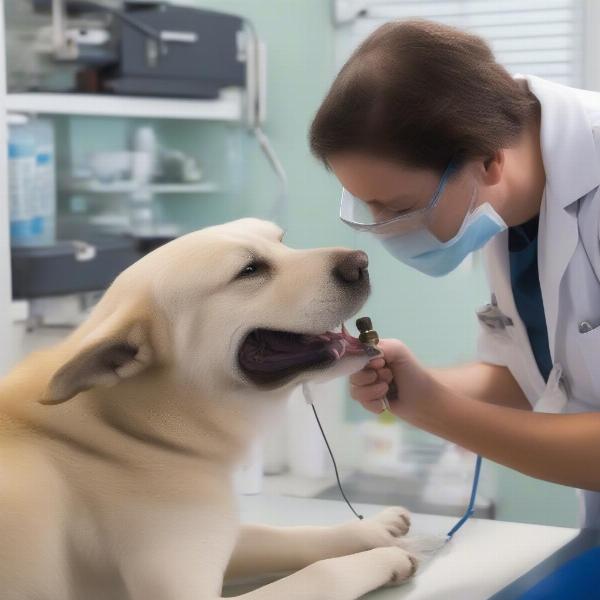Paraphimosis in dogs is a serious condition where the penis cannot retract back into the prepuce, or foreskin. This can lead to swelling, pain, and even tissue damage if left untreated. Searching for “pictures of paraphimosis in dogs” indicates a need to understand what this condition looks like, which is crucial for prompt recognition and treatment. This article will provide a detailed overview of paraphimosis, including its causes, symptoms, treatment, and prevention.
Recognizing Paraphimosis: What to Look For
Paraphimosis presents a distinctive appearance. The penis, typically concealed within the prepuce, remains exposed and engorged. The exposed tissue can become dry, inflamed, and even discolored. The dog may exhibit signs of discomfort, such as excessive licking of the area or difficulty urinating.
It’s important to distinguish paraphimosis from other conditions like phimosis, where the prepuce cannot be retracted to expose the penis. While both involve the foreskin, paraphimosis is the more urgent concern due to the risk of complications.
Causes of Paraphimosis in Dogs
Several factors can contribute to paraphimosis. These include:
- Trauma: Injury to the penis or prepuce during mating, fighting, or accidents can cause swelling and prevent retraction.
- Infections: Bacterial or fungal infections can lead to inflammation and constriction of the prepuce.
- Hair Rings: Hair can sometimes wrap around the penis, acting as a tourniquet and restricting blood flow. This is more common in long-haired breeds.
- Congenital Abnormalities: Some dogs may be born with a prepuce that is too tight, predisposing them to paraphimosis.
- Certain Medications: Some medications can cause priapism (prolonged erection), which can increase the risk of paraphimosis.
Treatment and Management of Paraphimosis
If you suspect your dog has paraphimosis, immediate veterinary attention is crucial. The treatment will depend on the severity of the condition.
- Lubrication and Manual Reduction: In mild cases, the veterinarian may apply a lubricating jelly and attempt to manually manipulate the penis back into the prepuce.
- Hyperosmotic Solutions: Applying hyperosmotic solutions can help reduce swelling and facilitate retraction.
- Surgical Intervention: In severe cases, surgery may be necessary to enlarge the prepucial opening or remove damaged tissue.
 Veterinarian treating a dog with paraphimosis
Veterinarian treating a dog with paraphimosis
Preventing Paraphimosis
While not all cases of paraphimosis are preventable, certain measures can reduce the risk:
- Regular Grooming: Keep the hair around the genital area trimmed, especially in long-haired breeds.
- Prompt Treatment of Infections: Address any signs of infection promptly to prevent complications.
- Careful Monitoring During Mating: Observe dogs carefully during mating to prevent injuries.
When to Seek Veterinary Help
Any instance of paraphimosis requires immediate veterinary attention. Delaying treatment can lead to serious complications, including tissue necrosis (death) and permanent damage to the penis.
FAQ
- What is the difference between paraphimosis and phimosis? Paraphimosis is the inability to retract the penis back into the prepuce, while phimosis is the inability to retract the prepuce to expose the penis.
- Is paraphimosis painful for dogs? Yes, paraphimosis can be very painful due to swelling and constriction of the penis.
- Can paraphimosis be treated at home? No, paraphimosis requires professional veterinary treatment. Attempting to treat it at home can worsen the condition.
- How long does it take for paraphimosis to heal? The healing time depends on the severity of the condition and the treatment required. Mild cases may resolve quickly with lubrication, while severe cases requiring surgery may take longer.
- Can paraphimosis reoccur? Yes, paraphimosis can reoccur, especially if the underlying cause is not addressed.
Conclusion
Paraphimosis in dogs is a serious condition requiring immediate veterinary attention. Understanding its causes, symptoms, and treatment options is crucial for responsible dog ownership. Regular grooming, prompt treatment of infections, and careful monitoring can help prevent this painful and potentially damaging condition.
ILM Dog is a leading online resource for dog owners worldwide, offering expert advice on all aspects of dog care and wellbeing. From breed selection and health to training and nutrition, we provide reliable and practical information to help you provide the best possible care for your canine companion. We specialize in Dog Breeds and Selection, Health and Medical Care, Training and Behavior, Nutrition and Feeding, Grooming and Hygiene, and Products and Accessories. For expert advice tailored to your dog’s specific needs, contact us today at [email protected] or +44 20-3965-8624. ILM Dog is committed to helping you nurture a happy and healthy relationship with your furry friend.